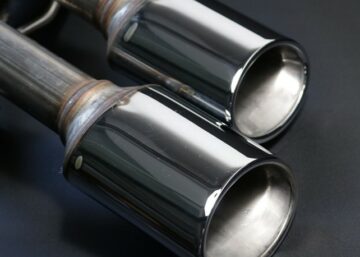Painting finish is one of the common forms of surface finishing and is integral to many industries, with the automotive industry being typical in its use. This surface finishing technique is crucial in the automotive design process as it allows manufacturers and designers to coat machined automotive parts with paints to improve aesthetics and functional properties.
The painting finish is compatible with many machined plastic auto parts. However, it requires certain technicalities to get the desired appearance, functionality, and quality. As a result, this article talks about painting plastic car parts, outlining the steps on how to paint plastic car parts, and factors needed to achieve a quality finish.
What is Painting Finish?
A painting finish is a surface finish applied to a material’s surface to improve its aesthetics and functional attributes. The paint contains several components such as the pigment which is responsible for its aesthetic properties, binders, and several additives which functions in the enhancing the functional properties of the part surface.
Choosing the right paint for an automotive car part depends on the knowledge of the functions and properties of the additives, pigment, and other components. For example, the automotive machine shop uses paint with UV stabilizers to protect surfaces coated with the paint from the effects of UV rays.
 Why Does a Machined Car Part Need to be Painted?
Why Does a Machined Car Part Need to be Painted?
There are many reasons why many automotive shops recommend using painting automotive plastic parts. Below are a few reasons why you should consider them.
1. Cosmetic Enhancement
Machining plastic parts most time leave visible marks on the parts. Sometimes, it can also lead to the part having a rough surface. Amidst the different surface finishing methods available, painting is an effective and cost-effective method to hide the marks and create a smooth appearance on the part.
2. Color Coordination
Using painting, it is possible to coat the machined plastic parts to match the color of a part of the car. This can help improve the visual appeal of the car as there is seamless integration with the car’s exterior or interior.
3. Provide Protection
Machined plastic parts, on exposure to UV light, moisture, or other environmental conditions, can experience several degradative reactions. However, the painting finish creates a protective barrier that shields the part from the effect of such environmental conditions.
As a result, painted plastic car parts do not experience color fading or any form of degradation, such as cracking, warping, etc., due to moisture or UV radiation.
4. Enhanced Durability
By acting as a painting layer, the finish improves the durability of the machined plastic part. Therefore, the machined plastic parts have enhanced scratch, abrasion, and wear and tear resistance. In addition, painting is a common choice in automotive machine shops for exterior car parts exposed to constant use and potential impacts. Examples of plastic parts include bumpers or side mirrors.
5. Branding and Identity
Painting is cost-effective for automotive manufacturers and designers to ensure branding and identity. It is easier to choose from the wide range of colors available for logos and emblems and establish brand recognition or convey a particular style.
Various Types of Paints Used for Automotive Parts Painting
There are several types of paints you can use for automotive parts painting. Each type has unique properties, advantages, and applications. Below are the common options available:
 1. Acrylic Enamel Painting
1. Acrylic Enamel Painting
This plastic paint for cars is durable and provides a glossy finish. Furthermore, there is excellent adhesion to the machined plastic surface. As a result, they are applicable in painting plastics in environments that predispose them to fading and chipping. The glossiness prevents the effect of UV radiation and covers scratches. In common, acrylic enamel paint is used in painting the plastic side mirror cover.
2. Acrylic Lacquer Paint
They have a high gloss finish, good adhesion, and can achieve a smooth surface. As a result, acrylic lacquer plastic paint for cars gives a sleek and polished look. Furthermore, this makes them a good choice for enhancing the vehicle’s overall aesthetic appeal.
3. Water-based Paint
Water-based paints are environmentally friendly, with good coverage, quick drying times, and low odor. They are better for painting automotive plastic parts like the dashboard and door panel. They are efficient due to their fast-drying nature and are eco-friendly due to the minimized release of harmful chemicals into the environment.
4. Polyurethane Paints
Polyurethane paints come in different colors and sheens and are known for their exceptional durability, and resistance to chemicals, and UV rays. They are the ideal choice for exterior painting automotive plastic parts due to their high durability and resistance properties, ensuring they remain intact even in harsh weather conditions.
 How to Paint a Car Part: Step by Step
How to Paint a Car Part: Step by Step
Although there can be differences depending on the manufacturer or the automotive machine shop, every automotive painting finish follows the general steps highlighted below:
1. Preparing for Painting
The first step is to prepare for the painting finish, comprising four different sub-steps.
- Identifying Suitable Plastic Parts for Painting
The first thing to do is to identify the compatibility of the machined plastic part with the painting process. Consider factors like adhesion, making materials such as ABS, and PC good for painting.
-
Clean the Plastic Car Part
After selecting the plastic and appropriate machining, clean the surface to remove contaminants, including dirt, dust, etc. You can use a mild-action detergent or a recommended plastic cleaner. Cleaning the machined plastic car part will ensure better adhesion between the painting and the surface.
-
Sanding
Although this might not be required due to the machining effect creating such texture, you can sand the surface to improve the adhesion between the paint and the plastic surface. You can sand the surface lightly with fine-grit sandpaper. Sanding also helps remove any gloss or imperfections present on the part, further improving adhesion.
-
Apply a Primer
Primer will improve the adhesion of the main paint to the surface of the plastic part. A specially made automotive plastic primer can improve the bond between the paint and the plastic surface, providing long-lasting results.
2. Choosing the Right Paint
The right automotive paint can be the difference between a successful automotive paint finish and an unsuccessful one. Select the right paint using the following factors.
-
Automotive-Grade Paints
Automotive grade paints differ from others due to their specification for auto plastic parts. As a result, you should only use paints specifically formulated for automotive applications. Not using such paints will expose painted auto parts to harsh conditions such as fading and cracking.
-
Durability
The automotive paint should have good adhesion properties and chemical and UV resistance. These properties will ensure the painted plastic auto parts do not degrade, or deteriorate over time. Furthermore, a durable paint will ensure that the part does not lose its functional and aesthetic appeal over time
-
Color Options and Finishes
Where aesthetics and color coordination are important, considering the color option and finish can be the difference between a visually appealing car part and the opposite. Automotive paints come in a wide range of colors and finishes, and they help in ensuring seamless integration and a cohesive appearance.
 3. Painting Process
3. Painting Process
The painting process comprises the following:
-
Setting up a Suitable Workspace
The right workspace should be a well-ventilated area and have good lighting. Furthermore, you can also choose drop cloths or plastic sheets to protect the surrounding from paint particles settling on nearby surfaces. The workspace size depends highly on the size of the auto car parts but should also be kept clean and well-maintained.
-
Applying Paint Using Spray Cans or Airbrushing Techniques
The application of the paint depends on preference and part complexity. There are two methods for auto car parts: spray cans or airbrushing.
On the one hand, spray cans are suitable for small parts. On the other hand, airbrushing is more suitable for complex parts due to the higher control and precision. As a result, automotive car painting relies more on airbrushing, even coverage, and a seamless color transition.
-
Ensuring Even Coverage and Avoiding Drips
The application of the automotive car paint should be thin and even to ensure a smooth finish. A thick or heavy application can lead to the formation of drips or uneven texture. As a result, to achieve a thicker finish, you can apply the paint in multiple thin coats, allowing the previous coat to dry before applying the next. Using this approach will guarantee a uniform and professional-looking automotive finish.
4. Finishing Touches
The painting also includes finishing touches to improve the painted parts’ aesthetics or functional properties. Below are a few finishing touches you can consider:
-
Applying a Clear Coat
After the paint dries, add a clear coat to add shine and enhance the painted surface’s durability. Furthermore, the clear coat protects the surface from UV rays, chemicals, and minor scratches, adds depth, and makes the surface glossier.
-
Sanding and Buffing
You can also sand the painted surface and polish it to achieve a smoother or glossier surface or to remove any imperfections. This step is critical as it helps achieve a showroom-quality finish (flawless and mirror-like finish)
-
Removing any Imperfections or Overspray
Inspect the auto car part for the presence of any form of imperfection or overspray. If present, use appropriate techniques such as wet sanding to address these issues. This is important to achieve high-quality standards.
Conclusion
Painting plastic car parts is crucial in improving the visual appeal, protecting plastic car parts, and improving the functional properties of the parts.
Painting a plastic car part requires careful attention to detail and should be given to quality-focused service providers. At WayKen, we offer one-stop custom machining and surface finish services for your metal and plastic car parts. Our experts are always ready to transform machined plastic auto parts into visually appealing and durable components.
FAQs
Can I paint plastic car parts myself?
Yes, you can paint your plastic car part yourself. However, you must have the required materials and knowledge to achieve good results. As a result, outsourcing to a quality-focused painting service provider can help you achieve a more professional finish.
What type of paint should I use for painting plastic car parts?
The best paint for automotive car parts according to car enthusiasts is the Rust-Oleum® Paint. They have good adhesion, improved durability, and resistance to UV, chemical, and other environmental factors
How long does it take for painted plastic car parts to dry?
This depends on the paint, humidity, other environmental conditions, and the number of coats applied. Every paint has its recommended time specified by the manufacturer and should be followed to prevent smudging, uneven finish, or other issues.




